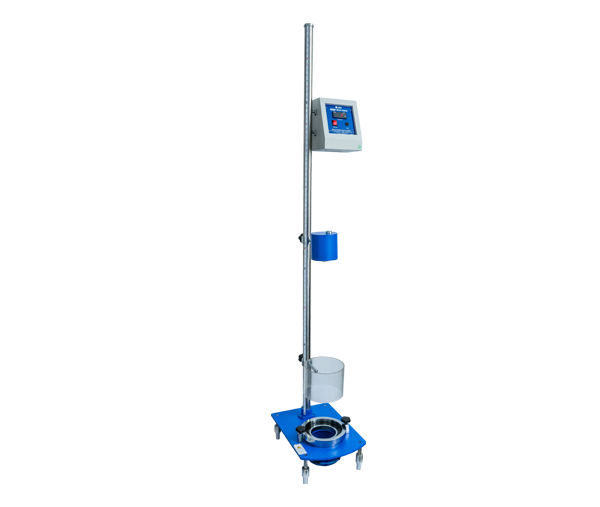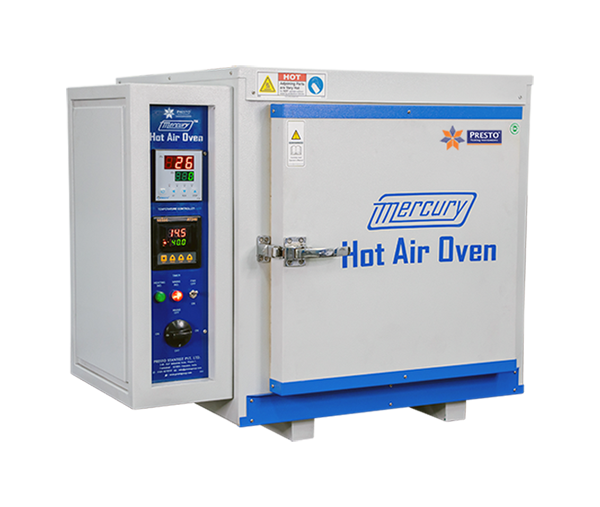
Environmental Stress Cracking Resistance
Environmental Stress Cracking is the brittle failure of polymeric material from a combination of stress and environment. The frequency of failure depends on the material properties, the environmental conditions, its level and type of stress under certain conditions of s..read more
If you wish to conduct the test accurately with the help of this lab testing instrument, then you need to first install this testing machine accurately. For this, you need to remove the packing and place the instrument on a flat surface preferably a concrete shelf. A single-phase socket should be near the ESCR instrument. Place the machine at a distance of 1 ft. clear from the wall. After that, you need to prepare the testing specimen. For this, you can take six samples of rigid plastics that you need to test, of size 38 x 13 mm (L x W) using the cutting tool provided with the machine. Draw a line of 19mm on the sample by maintaining the center. Make a hole in the center of the 19mm line using a nicking Jig pressing tool. Now place the sample in the bending tool, for not more than 10 minutes, to bend the sample. After bending the sample lift the sample using a lifter and place it in the fixture. Once you accurately place the sample, then you can start operating it.
For this, you can start the machine and turn ON the mains of the machine from the control panel and turn on the heater. After the required temperature for the test has been attained, now switch off the Mains and take out the test tubes from the bath to examine the effect of hot water on the sample and to determine whether the cracks develop on the sample or not. Set the PID controller and configure its lock to zero. Turn the auto-tuning ON and off and accurately conduct the test. In this way, you can easily perform the test.
Features of Environmental Stress Cracking Resistance
- This testing machine will provide you with highly accurate testing results.
- Temperature controls through PID controller
- Highly accurate test results under uniform temperatures in the chamber
- Advanced Digital Microprocessor based PID based temperature controller
- Provision of Set Value(SV) and Process Value(PV) on the temperature display
- Inbuilt Auto tuning function
- Bright LED display
- Equipped with rapid heaters for uniform and homogenous heating and maintaining the temperature inside the chamber
- The integral water drain system
- Inbuilt Calibration features with reference to master PID controller
- Stirrer motor for the precise stirring of the sample inside the tank and for uniformity of temperature
- A set of Test tubes along with a fixture to hold samples inside the tank
- It is designed as per Indian & International standards.
Technical specifications
- The machine easily operates on Single Phase 230 V, 50Hz.
- The inner bath of the machine is made up of stainless steel and the outer body is made of mild steel duly powder coated.
- The machine is incorporated with six numbers of stations.
- The visual appeal is enhanced by the autumn gray and blue combination painting and zinc plating to ensure resistance to corrosion.
- Temperature Range (For Silicone Oil): From ambient to 250° C.
- Temperature Range(For Water): Ambient to 90ºC
- Least Count/Resolution: 1ºC
- Accuracy: ± 2ºC
- Display: LED(Digital)
- Motor: 1/5 HP
Related Products

Vibration Table

TP800 Spectrophotometer

Color Matching Cabinet Spectrum – I (ASIA)

Dart Impact Tester – PRIMA SERIES
Environmental Stress Cracking Resistance
out of
Environmental Stress Cracking is the brittle failure of polymeric material from a combination of stress and environment. The frequency of failure depends on the material properties, the environmental conditions, its level and type of stress under certain conditions of stress, and other presence environments like wetting agents, soaps, detergents, oils. If you are looking for one of the highly accurate testing instruments to detect the change in the physical properties of the material, then we suggest you go with Environmental stress cracking resistance tester.
Presto’s Environmental Stress Cracking Resistance Tester is strictly designed as per ASTM D-1693 – 15. This testing instrument has been specially designed for evaluating the effect of the environment on blow-molded polyethylene containers. Presto offers ESCR as it is the efficient solution for Plastic industries to check the environmental stress–cracking of ethylene plastics. Environmental Stress cracking is a property that is highly dependent upon the nature and level of the stresses applied and on the thermal history of the specimen. Environmental stress cracking is the formation of cracks in a material caused by relatively low tensile stress and environmental conditions. Environmental Stress-Cracking Resistance (ESCR) is the number of hours that 50% of the specimens tested exhibit stress cracks. The instrument tester is accompanied by standard accessories such as cutting die, glass tubes, digital temperature controller, and foils. The aesthetic appeal is enhanced by the autumn gray and blue combination finishing and bright chrome/zinc plating to ensure resistance to corrosion.
Blow-molded polyethylene containers exhibit involuntary failure by cracking at stresses substantially below those that would cause cracking in the absence of such environments. Test methods of ESCR are clearly described in various standards that can be used to calculate the environmental stress- crack resistance of plastic containers. Presto’s Environmental Stress Cracking Resistance is designed as per ASTM D 1693 to evaluate the effect of the environment on blow-molded plastic containers. It is influenced by the design of the container, molding conditions, treatments during and after production, and other related factors that affect this. This test procedure helps plastic manufacturers to separate and identify the effect of the related factors on the stress crack resistance of the container. The machine is supplied with standard accessories like a digital temperature controller, cutting dies, foils, and glass tubes.
ESCR testing is performed by slowly bending the test specimens and placing them in a holding clamp. The clamp and specimens are then placed in a test tube and immersed in a specified reagent. The test tube is sealed and placed in a constant temperature bath. Multiple test specimens are tested at one time. Specimens are inspected periodically for failure. Cracks generally develop at the notch, perpendicular to the notch, and run to the edge of the specimen. Any cracks constitute failure, not just cracks that reach the edge of the specimen. Cracks sometimes appear beneath the surface and are visible as surface depressions. If depression develops into a surface crack the time at which the depression was noted is taken as the time of failure. This lab testing instrument has been fabricated from mild steel with duly powder coating.
If you wish to conduct the test accurately with the help of this lab testing instrument, then you need to first install this testing machine accurately. For this, you need to remove the packing and place the instrument on a flat surface preferably a concrete shelf. A single-phase socket should be near the ESCR instrument. Place the machine at a distance of 1 ft. clear from the wall. After that, you need to prepare the testing specimen. For this, you can take six samples of rigid plastics that you need to test, of size 38 x 13 mm (L x W) using the cutting tool provided with the machine. Draw a line of 19mm on the sample by maintaining the center. Make a hole in the center of the 19mm line using a nicking Jig pressing tool. Now place the sample in the bending tool, for not more than 10 minutes, to bend the sample. After bending the sample lift the sample using a lifter and place it in the fixture. Once you accurately place the sample, then you can start operating it.
For this, you can start the machine and turn ON the mains of the machine from the control panel and turn on the heater. After the required temperature for the test has been attained, now switch off the Mains and take out the test tubes from the bath to examine the effect of hot water on the sample and to determine whether the cracks develop on the sample or not. Set the PID controller and configure its lock to zero. Turn the auto-tuning ON and off and accurately conduct the test. In this way, you can easily perform the test.
Features of Environmental Stress Cracking Resistance
- This testing machine will provide you with highly accurate testing results.
- Temperature controls through PID controller
- Highly accurate test results under uniform temperatures in the chamber
- Advanced Digital Microprocessor based PID based temperature controller
- Provision of Set Value(SV) and Process Value(PV) on the temperature display
- Inbuilt Auto tuning function
- Bright LED display
- Equipped with rapid heaters for uniform and homogenous heating and maintaining the temperature inside the chamber
- The integral water drain system
- Inbuilt Calibration features with reference to master PID controller
- Stirrer motor for the precise stirring of the sample inside the tank and for uniformity of temperature
- A set of Test tubes along with a fixture to hold samples inside the tank
- It is designed as per Indian & International standards.
Technical specifications
- The machine easily operates on Single Phase 230 V, 50Hz.
- The inner bath of the machine is made up of stainless steel and the outer body is made of mild steel duly powder coated.
- The machine is incorporated with six numbers of stations.
- The visual appeal is enhanced by the autumn gray and blue combination painting and zinc plating to ensure resistance to corrosion.
- Temperature Range (For Silicone Oil): From ambient to 250° C.
- Temperature Range(For Water): Ambient to 90ºC
- Least Count/Resolution: 1ºC
- Accuracy: ± 2ºC
- Display: LED(Digital)
- Motor: 1/5 HP





